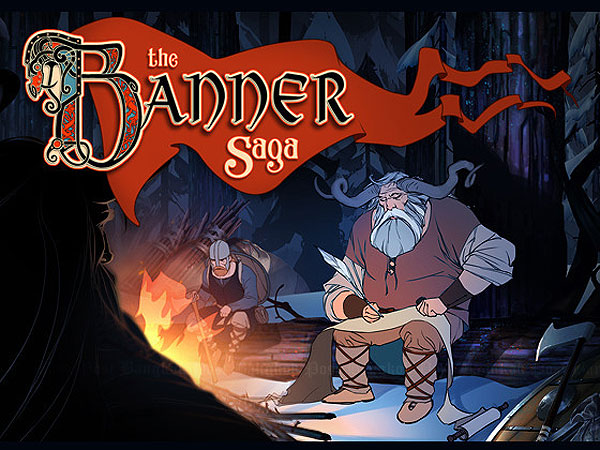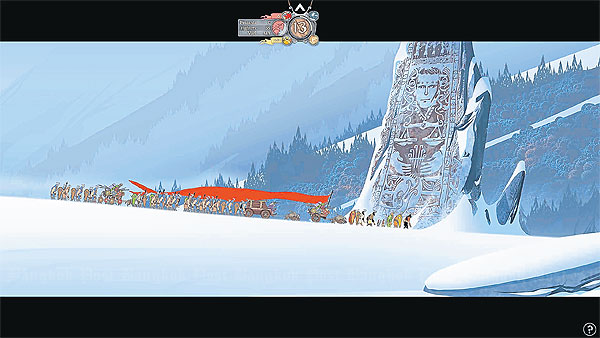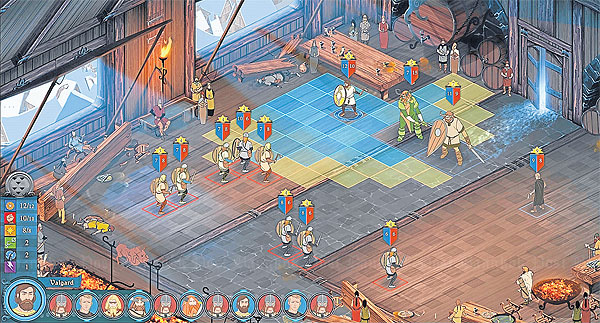
Perhaps because video games are often, and wrongly, viewed solely as technology, they are thought by many to be perpetually improving. And sure, the past few decades have brought changes. Visuals have shifted from ragged, chunky blocks to three-dimensional computer animation. Sounds have gone from either nonexistent _ as in the text adventure games of the 1970s and 80s _ or blips and bleeps to fully recorded voice performances and orchestral scores that sometimes rival the best productions for film and television.
But newer isn't always better. People still play Ms. Pac-Man and Tetris, after all. What to make, then, of something like The Banner Saga, an unusual and sometimes skillful blend of old and new?
The Banner Saga _ a PC game featuring Viking-like humans and mythical creatures _ has two-dimensional, often static artwork modelled on the hand-drawn imagery of classic Disney films rather than the precision of Pixar. (Eyvind Earle, who painted the background for Sleeping Beauty, is cited in the game's credits for ``art inspiration''.) The voice acting here is minimal, with most storytelling done through words that must, yes, be read to be understood.
The spare text and the lavish-but-retro art are, however, accompanied by a first-rate score by Austin Wintory, who received a Grammy nomination last year for his composition for the PlayStation 3 game Journey. In The Banner Saga's credits, Wintory's team far outnumbers the people involved in the programming, writing, design or animation. (There are as many people _ three _ listed for their involvement merely on the soundtrack's Icelandic vocals as there are working at Stoic Studio, the company in Austin, Texas, that is behind the game.)
The only team in the credits that outweighs the musicians is the collection of backers on Kickstarter, more than 4,700 of whom paid at least $25 (820 baht) on that crowd-financing website in the spring of 2012 for the privilege of seeing their names there. In all, Stoic Studio raised more than $700,000 from more than 20,000 people who wanted to see this game made. (Seven people paid at least $2,500 for the right to have a likeness appear as ``a unique deity'' in the game.)

The Banner Saga was only one of two prominent Kickstarter-financed games released on Tuesday. The backers of Broken Age, a point-and-click adventure from Double Fine Productions that received $3.3 million from 87,000 people a month before The Banner Saga raised its money, have been given download codes for their game, two weeks before it goes on sale to the public. Like The Banner Saga, Broken Age is a bit of a throwback.
It's written and directed by Tim Schafer, who worked on beloved 1990s games like The Secret Of Monkey Island and Grim Fandango but hasn't made a point-and-click game _ named for the movement of the mouse on a computer screen _ in almost 20 years.
The business model for relatively low-budget games like The Banner Saga and Broken Age _ made by small teams for six or seven figures _ seemed to have disappeared a few years ago as game studios focused on making blockbusters for northward of $100 million. The combination of crowd-financing on Kickstarter and digital distribution, especially on the popular Steam store, promises to not only increase the number of video games that are made but also to make available a more diverse array of them.
The style of play that The Banner Saga favours _ turn-based tactical battles that resemble the holographic chess that Chewbacca and R2-D2 play in Star Wars _ has been undergoing a renaissance. Well-received games like X-COM: Enemy Unknown and Fire Emblem: Awakening have been released since those Kickstarter backers chipped in their $700,000.

The Banner Saga has artwork modelled on the hand-drawn imagery of classic Disney films rather than the precision of Pixar.
Still, this game's backers are unlikely to have been sated. The battles in The Banner Saga _ involving those Viking-like humans, a race of horned creatures (called ``varl'') and stone colossi (``dredges'') _ are tense and engaging. Unlike in the recent X-COM and Fire Emblem games, losing a character in battle doesn't mean that you've lost that character forever, which makes The Banner Saga slightly easier to play even as it lowers the stakes. A section that resembles the educational game Oregon Trail, asking players to manage supplies for a caravan of settlers, is less successful. For a game that requires this much reading, the prose is never more than workman-like, though it is, thankfully, clear of melodrama. The Viking-like names and settings can seem impenetrable at first (``I'm Fasolt. Ulfar's still in Schlid.'')
Yet the story is well-plotted and set in an original world with a deep mythology and history, even if it approaches boilerplate high fantasy: The gods are dead. The sun is frozen. War has returned. The end of the world is nigh.
I have a high tolerance for talk of menders and Loom-mothers and godstones, and yet I found myself rushing through The Banner Saga's character conversations so I could get back to its battles. Still, even in those moments when I hurriedly clicked through text, the game was beautiful to listen to.
NEW YORK TIMES
How do you like this game review? If you have any suggestions, please don't hesitate to share them on http://www.facebook.com/studentweekly.
You can also read previous articles here.


